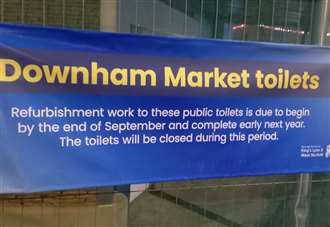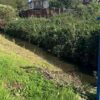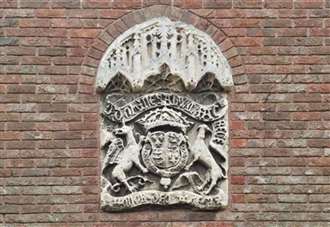-
 play_arrow
play_arrow
Kl 1 Radio Local radio for west Norfolk
-
 play_arrow
play_arrow
KL DISCO KL Disco Playing Disco Music from the 70's onwards.24/7
-
 play_arrow
play_arrow
KL COUNTRY KL COUNTRY Playing New and Classic Country Music 24/7
-
 play_arrow
play_arrow
KL ROX KL ROX The best of New and Classic Rock.24/7
-
 play_arrow
play_arrow
KL SUMMER Summer Vibes 24/7 from KL1 Radio across West Norfolk
-
 play_arrow
play_arrow
KL CLASSICAL Your Symphony Starts Here
-
 play_arrow
play_arrow
KL CHILL Just Chill!
-
 play_arrow
play_arrow
KL POP The Best POP Hits all day Long!
-
 play_arrow
play_arrow
KL XTRA KL XTRA
music_note
Your views on plans to chop ancient oaks, an ‘incriminating sign’, grey squirrels and farmers


Here are the Lynn News letters for Friday, January 10, 2024…Options over felling trees not fully debatedRobert Gardner (Letters, December 27) describes the plan to fell eight mature oak trees at the Queen Elizabeth Hospital in Lynn “a disgraceful disregard of preservation orders”.
The trees (a mix of very large, large and medium oak) occupy land selected to build a sterile services unit.The planning application lists eight alternative on-site locations.One location, for example, is space leased to the ambulance service. Was the ambulance service approached to find out if there could be an alternative site for them? Another option was discounted because of a pedestrian link. Was the possibility of creating a link elsewhere looked into?These locations were not fully debated by the planning committee because the sifting panel decided not to ‘call in’ the application. To review each of the options may seem a lot to ask but as the council’s arboriculture officer pointed out these trees are “irreplaceable”.The contribution of oak trees to landscapes, biodiversity, culture and economy is enormous.A live oak is the most effective tree at capturing carbon. Over the course of its lifetime, it can capture 10,994 equivalent pounds of CO2. Oak trees also assist the soil in absorbing and storing carbon. By absorbing carbon dioxide from the air, storing it in the soil and trees and releasing oxygen into the atmosphere as they grow, trees reduce the rate of climate change.But perhaps their greatest feat is nurturing wildlife. They are a haven for a colossal 2,300 wildlife species, providing vital spaces to eat, shelter and breed.Over 40 years ago the people responsible for building the hospital recognised these same trees’ importance by building around them.Yes, there is the promise to plant young trees as mitigation but it would take decades before newly planted trees fulfil the environmental and biodiversity functions of these mature trees. And of course, that also depends on the replacement trees surviving.According to the borough’s Local Plan natural resource protection and environmental enhancement are priorities.A sterile services building must be built but cannot the extra mile be ran to try to find a solution that allows these trees to continue to benefit the environment and people of West Norfolk?Tree Preservation Orders are given to protect trees and woodlands if their removal or changes to them would have a significant impact on the local environment”. That has not changed. Jenny WalkerRoydon
Well, they don’t say which year!I’m sure there is a logical reason for persisting with this somewhat incriminating sign and I can only assume the borough council’s caveat is they’ve avoided mentioning which year… classic.Steve Mackinder DenverThese are just rodents with bushy tailsI enjoy reading the correspondence of Alan Mudge in Viewpoint and agree with some of the contents, but I have reservations about his photograph in Picture of the Week on December 27, showing a grey squirrel eating bird food from a pergola.It looked cute and fluffy and undoubtedly some readers will enjoy looking at the snapshot, but there is a largely unknown side to this pestilent visitor to our gardens.
They were classed legally as vermin by the Wildlife and Countryside Act in 1981 for good reasons attributable to their contributions to destruction. Grey squirrels are notorious for meddling into nests, eating bird eggs and even fledglings, and they also have a propensity for plant ruination, adding up to a health hazard. They were brought to the UK from North America in the 19th and 20th centuries and wiped out most of our native red squirrels which are relatively harmless.Grey squirrels are rodents with bushy tails, yet the same admirers are fearful of sewer rats entering gardens with similar diseases to those of their cousins, so any affection is misplaced.If my garden was invaded by these unwelcome creatures, I would have no compunction about engaging pest control at the council if any of these parasites invaded my bird table, especially during the nesting season. There will be those who will call me a killjoy for writing this letter but factual information must trump sentimental fallacies.David Fleming DownhamHow concerned should we be about new bill?Philip Wagstaff’s response to my letter suggesting a tax on farms could make land available for even more solar panels sounds like the politics of envy.I know that there are vast acres owned by a handful of people and organisations and I would have no trouble in seeing them pay a fairer share of tax, if it is known that such ownership is to take advantage of substantial tax breaks. What is of concern to the vast majority, including non-farming people, is a means of destroying the huge number of working farms that supply our food, by pretending they are all millionaires. With regards solar panels, were we already in a position to have all our energy from these much vaunted panels and wind turbines, how many of us would have experienced black-outs over Christmas, when the weather proved in every respect, to be unsuitable for both means to supply much if anything from their respective systems?They may have a contribution to make in the supply of energy but I don’t hear very much about the rank hypocrisy of such devices being manufactured in China (the biggest polluter of all) who take up our share of pollution because we do not make all these systems ourselves.If indeed your readers are concerned about the planet and the way this government is now pushing even harder for net zero, they may wish to look into The Climate and Nature Bill (CAN), a private members bill that will have its second reading on January 24.While by its nature it may well not make it into law, it would appear to have the support of three Norfolk MPs, including our own Terry Jermy.On reading the information about the outcome of this bill, its requirements could not only be draconian but at vast cost to the nation.It is not possible to quantify the extent of scrutiny such an open-ended bill would receive in parliament when Net Zero was imposed on us after a paltry 90 minutes of debate.The World Resources Institute has summarised what will be required from us: “To achieve net-zero emissions, rapid transformation will be required across all global systems – from how we power our economies, to how we transport people and goods and feed a growing population.”All this has the appearance of net zero on steroids, so how concerned should we be about the possibility that the CAN Bill could become a reality?Mrs José O’WareMethwoldWe need to look after our farmersI would like to reply to Philip Wagstaff: ‘So where are all these local landowning farmers?’It is pretty clear that Mr Wagstaff is not a country person or he would be well aware of many farming families from Norfolk.The inheritance tax this Government is trying to push through is not good in my countryman’s eyes.Family farms are the backbone of this country, with people working from dawn to dusk to keep them running.The estates he quoted have been here for many years. I am well aware of some foreign land owners but there are still many family farms.In my younger days, I used to help on some of these farms during harvest times and many of these farms are still being run by the next generation.We need to look after family estates – these farmers need all the support they can get.Then we get on to solar energy. I do accept we need to do something about this and some land has to be taken – but not the amount that is at the moment.Why not bring in a building regulation so there are new panels on all these new houses the Government is proposing?David WrightEast Winch
Similar posts
Upcoming shows

James Roberts – Saturday Anthems
6:00 pm - 8:00 pm

Liam Walsh – Guilty Pleasures
8:00 pm - 10:00 pm

Jonathan Charles – Best Disco In Town
10:00 pm - 11:00 pm

Night Trax
1:00 am - 6:00 am

Weekend Back Trax
6:00 am - 8:00 am
-

Presidents prime ministers and cardinals gather for funeral of Pope Francis

Town clothing store soon to get click and collect service

Knife offender breached court order because his ankle tag caused him ‘injury’

Have a crack at the toughest pub quiz on the internet

Disqualified driver riding electric bike caught out by plain-clothed officers
Message Us
Copyright The Mediasite UK - 2025



